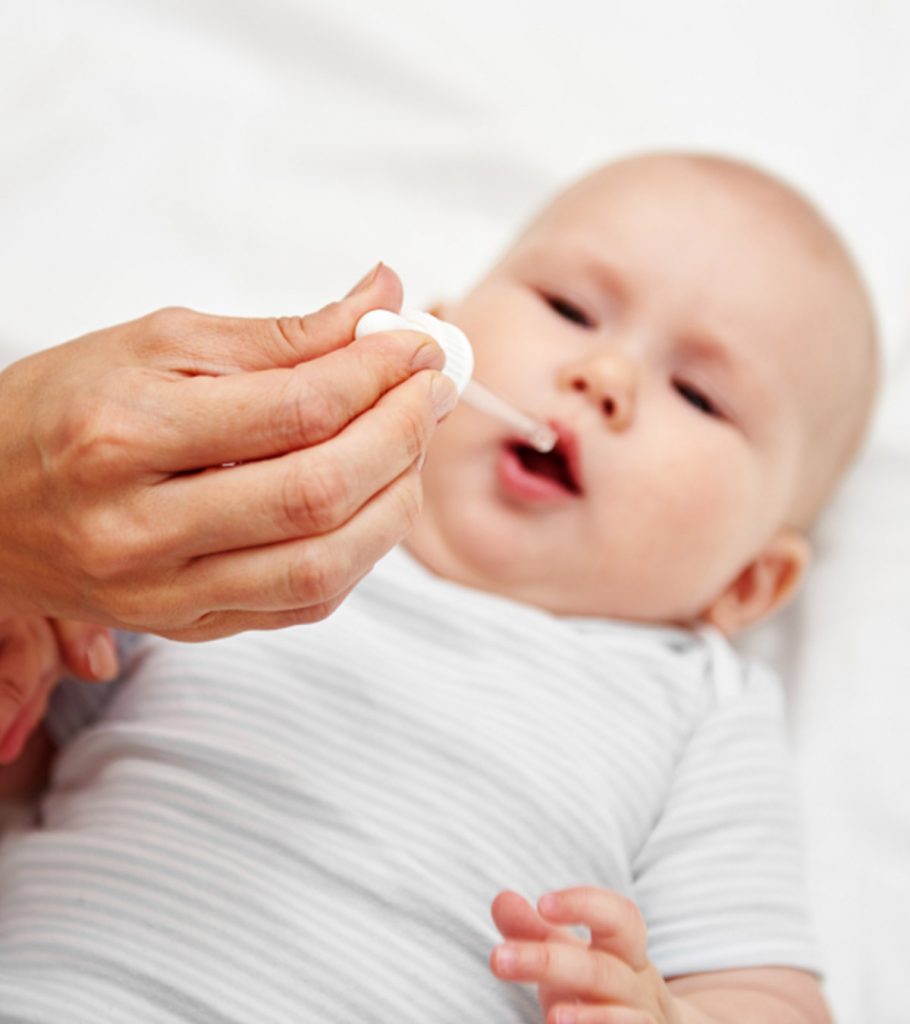Intestinal gas is common in babies and is caused by their immature digestive systems. Gas is a leading cause of colic in infants (1). Therefore, gas drops for babies are commonly used to relieve excess gas and abdominal discomfort.
Babies may cry, especially during the night, due to gas problems. In most cases, gas in babies is not a serious problem, and it subsides with time. However, excessive crying can interfere with a baby’s sleep and feeding patterns.
Read this post to know more about the safety and efficacy of gas drops in babies.
What Are Gas Drops?
Gas drops are over-the-counter (OTC) liquid medications used for relieving gas in babies. It contains simethicone, a silicone latex that disperses and prevents gas bubbles from forming in the gastrointestinal tract (2).
How Safe Are Gas Drops For Babies?
As gas drops are available as OTC medication, the Food and Drug Administration (FDA) does not review and approve them. However, they are marketed if they comply with applicable regulations and policies (3).
Simethicone, the active ingredient in most gas drops, is non-toxic and is not absorbed by the body. So, it is considered safe for infants and newborns (4). However, it may cause loose stools in some babies (5).
If your baby has severe gas that makes them fussy and irritable, consult your pediatrician promptly.
What Is The Recommended Dose For Babies?
It is best to follow the dosage prescribed by your pediatrician. The standard dosage for children and infants less than two years is 20mg orally four times daily (6). According to Dr. Leah Alexander, a pediatrician from Fairview, New Jersey, “It is recommended to administer gas drops to children under two only four times a day, with approximately six hours between doses if necessary. If a baby’s gas symptoms do not improve or seem to worsen while taking gas drops, parents should contact their baby’s healthcare provider.”
Here is the dosage chart (3)
| Age (yr) | Weight (lb) | Dose (ml) |
| Infants under two | Under 24 | 0.3 |
| Children over two | Over 24 | 0.6 |
How To Administer Gas Drops For Babies?
Gas drops containing simethicone work best when they are taken after meals or at bedtime. Always use the measuring spoon provided with the medicine to get an accurate measurement.
You can administer the medication orally, with the help of either a spoon or a dropper. Pour the liquid slowly, and aim for the sides of the mouth to prevent choking or spitting.
It can also be mixed with 30ml (1oz) of water, baby formula, or other liquids to make it easy for your baby to swallow (3) (7).
How Effective Are Gas Drops?
A study conducted on 51 healthy infants aged between two and 12 weeks to prove the efficacy of simethicone in infant colic relief treatment found that 78% of them showed improvement, and the symptoms resolved after one day of treatment using simethicone. In 85%, the same results were obtained after seven days (8).
What Are The Side Effects Of Gas Drops?
Although the side effects are rare, some babies may exhibit the following symptoms when they are allergic to the medication.
- Hives
- Swelling of the lips, tongue, and throat
- Difficulty in breathing (7)
If you notice any of these reactions in your baby, stop using the medicine and seek medical advice.
What Are The Precautions To Be Taken?
It is advisable to take the following precautions while administering gas drops to your baby.
- Always use the measuring spoon provided to ensure you measure the correct dosage.
- If you have mixed the medication with water or baby formula, use it immediately.
- Ensure you do not exceed the standard dose.
- Although it is relatively safe, use the medication only for a limited time as prescribed by your doctor.
- Some gas drop formulations may have harmful additives or flavor agents, which might cause allergic reactions in babies. So, always read the labels carefully before administering the medication.
Are There Any Alternatives To Gas Drops?
In the initial stages, you could consider alternative remedies to relieve the gas discomfort in babies.
1. Probiotics
Probiotics are good bacteria that can help your baby digest food better. A study on 589 infants found that oral supplementation of Lactobacillus reuteri during the first three months of life reduced the onset of colic, gas, and functional constipation (9).
2. Massaging
Gently massaging your baby’s tummy or bicycling their legs may help in releasing the trapped gas.
3. Burping
This could be a good way to release any trapped gas in your baby’s tummy while feeding. Make sure to burp your baby after each feeding.
Gas problems might make a baby irritable, thereby disturbing their sleep, making them even more cranky. In such cases, you may use baby gas drops after seeking a pediatrician’s advice. The FDA does not regulate these OTC, so their safety is not assured. But if the doctor approves the gas drops, only administer the suggested dosage. Alternatively, you may try a few home remedies to relieve babies from gas. Gas drops can be replaced by immediate burping after a meal and a gentle tummy massage. Also, check with your pediatrician the reasons behind the gas accumulation and take preventive measures as suggested.
Key Pointers
- Gas drops are over-the-counter medications containing simethicone as an active ingredient, relieving gas in babies.
- These gas drops are administered orally or mixed with baby foods.
- Following the ingestion of baby gas drops, some babies may develop breathing difficulties or swelling of the lips and tongue.
- Gas drops are not FDA-approved and hence consult your pediatrician before administering them to your baby.
- Massaging and burping are a few alternatives to gas drops.
Are you concerned about giving your 4-month-old baby gas drops or tablets? Discover the answers in this video, where we explore the potential risks and benefits.













